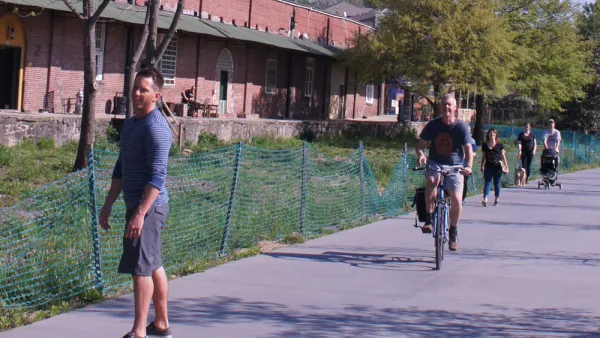While the neighborhoods on northern segments of the Atlanta's BeltLine has received 94 percent of funding invested towards parks and trails, segments to the south have received 86 percent of affordable housing investments.
A year-old report titled "An Atlanta BeltLine for All: Equitable Development Assessment" [pdf] was recently discussed on SaportaReport by David Pendered. The study was sponsored by the Atlanta BeltLine Partnership, funded by the Ford Foundation, and conducted by Nexus Research Group and Davidson Consulting. According to Pendered, "the Atlanta City Council created the plan in 2008, after public outcry over three significant acquisitions for the BeltLine in and adjacent to northeast Atlanta."
The findings of the report discuss resource allocation and investments made in the trails, parks, general corridor, and affordable housing within the five quadrants of the 22-mile BeltLine project, among other things. In the context of investment, Pendered highlights how "the BeltLine’s southwest area has received 5.5 percent of the total funds invested in BeltLine parks and trails, according to figures in the report. The actual investment is $7 million out of a total investment, as of the date of the report, of $126.8 million."
In addition, there is a vast difference between investment in affordable housing and investment in trails. Of the total $19.2 million invested in trails, "$12.9 million has been invested in the northeast and northside study areas and $6.3 million has been invested in southwest and southeast Atlanta." Indeed, most of the affordable housing is clustered in these southeast and southwest quadrants, 117 units have been funded there out of the total 131 at the time of the report's creation.
Much of the BeltLine's rhetoric has described it as a way to address the historic inequalities that exist in Atlanta along race and class lines.
FULL STORY: Atlanta BeltLine: North gets parks, trails; South gets affordable housing, according to little known report

Analysis: Cybertruck Fatality Rate Far Exceeds That of Ford Pinto
The Tesla Cybertruck was recalled seven times last year.

National Parks Layoffs Will Cause Communities to Lose Billions
Thousands of essential park workers were laid off this week, just before the busy spring break season.

Retro-silient?: America’s First “Eco-burb,” The Woodlands Turns 50
A master-planned community north of Houston offers lessons on green infrastructure and resilient design, but falls short of its founder’s lofty affordability and walkability goals.

Test News Post 1
This is a summary

Analysis: Cybertruck Fatality Rate Far Exceeds That of Ford Pinto
The Tesla Cybertruck was recalled seven times last year.

Test News Headline 46
Test for the image on the front page.
Urban Design for Planners 1: Software Tools
This six-course series explores essential urban design concepts using open source software and equips planners with the tools they need to participate fully in the urban design process.
Planning for Universal Design
Learn the tools for implementing Universal Design in planning regulations.
EMC Planning Group, Inc.
Planetizen
Planetizen
Mpact (formerly Rail~Volution)
Great Falls Development Authority, Inc.
HUDs Office of Policy Development and Research
NYU Wagner Graduate School of Public Service



























